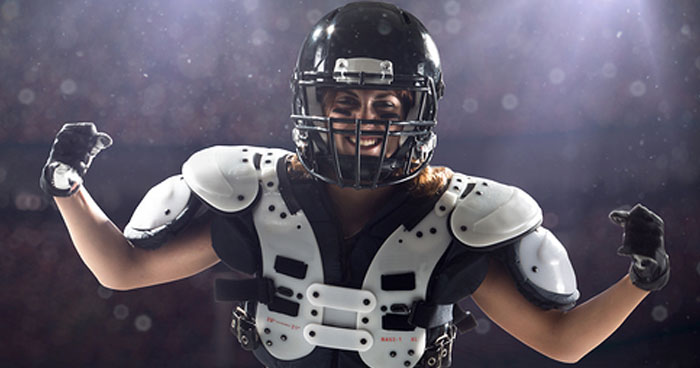A Woman-to-Woman Football Guide

There are some basic truths about me. I talk too much, laugh too loud, and give my opinion a bit too freely. I am superstitious to a fault and have been known to call out complete strangers for putting their hat on a table or splitting a post. Oh, and I LOVE football!
It all began back in 1972 when I developed a somewhat serious crush on Larry Csonka, #39 for the Miami Dolphins. I credit my Uncle Tommy for introducing me to the fascinating world of pro football. As we spent Sunday afternoons watching our beloved Dolphins achieve perfection with an undefeated season, I became hooked. I was fascinated by a sport that few girls seemed to care about, and I worked to learn every aspect of the game.
In high school, as my gal pals chatted and socialized in the football stadium bleachers, I yelled passionately at the refs for missed calls; screamed at the quarterback when I perceived the approaching blitz; and cheered for the defense achieving a 4th and inches shut down. I did not dream of being a high school cheerleader, but I would have loved to have been the kicker.
It was very much by design that in 1981, when contemplating the daunting task of choosing where to attend college, I selected Florida State, home to the Seminoles. To note that I am a rabid FSU football fan is a serious understatement.
Now, each August I wait impatiently for the month to tick down. I eagerly peruse the football season schedules and fill my weekend calendars with games to watch and attend. But here’s the thing: I want my gal pals to join me in this gridiron lovefest. I strongly believe that if you just understood the basics of the game, you too would bask in the sweet, sweet glow of a college game day victory celebration. Do not allow yourselves to be relegated to the half-time party snacks table.
Football can seem somewhat complicated. Provided here are some basic terms that, when mastered, will help you keep up with and enjoy the game:
- Who’s the home team? The home team wears the dark jerseys, the visitors usually wear white or light colored uniforms. Figure out early on who you are cheering for; watching the game will be more fun if you pick a side. Tip: never cheer against the Noles.
- Why do games last three hours? There are four 15 minute quarters in a game, two quarters in a half. So why do games take so long to complete? Because each team receives 3 timeouts per half. And, there’s a “halftime” between the second and third quarter when each team goes back to their locker room for a brief rest (and usually some sort of pep talk from the coach). The clock also stops for lots of reasons such as penalties (see below) or when a player gets injured. In televised games, there can also be commercial time outs. This is always a good time for a bathroom break or to refresh your cocktail.
- What’s a quarterback? The quarterback is the guy who stands behind the line of players. Another player called the center hikes the ball to him up through his legs. Yeah, I know, it’s funny. You get used to it. Once the quarterback has the ball he has a few options: he can throw the ball to a player called the receiver; he can give the ball to another player who will run with it until someone either knocks him down or pushes him off the field; or the quarterback can run with the ball. This last option can be a bit terrifying to watch–you never want your quarterback to get injured. By the way, the quarterback is often the cutest guy on the team, one more reason you don’t want to see someone knock the snot out of him.
- How do teams score points? There a few ways teams can score points. A touchdown is when someone carries the football into the end zone (that’s the colorful turf at each end of the field). Teams receive 6 points each time they are able to get the ball into the end zone. If a team scores a touchdown, they have two options for additional points: they can kick the football through the goal posts for one extra point, or instead run the ball into the end zone again for what’s called a two-point conversion. Note that for either the extra point or the 2-point conversion they’ve got one play, one shot. Consequently, the most stressed out player on the team is usually the kicker–the entire game often hangs precariously in the balance, dependent on the kicker’s ability to get the ball through the uprights (goal posts).
If a team can’t reach the end zone, but they’re close–usually within 25 yards or less of the end zone, on a fourth down (see below) they can kick a field goal through the goal posts for 3 points. A team can also score 2 points from a safety, but we’ll cover that another day.
- What are “downs”? When a team has possession of the ball, they are playing offense. When a team does not have possession of the ball, they are playing defense. When on offense, a team has four “downs” or plays to move the ball ten yards or more. Every time a team moves the ball ten yards or more, that is called getting a first down, and the count to move the ball another ten yards starts over again. Just remember, getting a first down is very important; it means the offense gets to keep possession of the ball.
- What’s a penalty? Football has a lot of rules, too many to be explained thoroughly here. Each time a referee determines that a player breaks a rule, the team is penalized. I know, the entire team! The severity of the penalty imposed depends on the importance of the rule that has been broken. For example, there are minor infractions, like when a defensive player moves into the offensive space before the center gives the ball to the quarterback – this is called off sides and the penalty is five yards. Then there are serious infractions, such as personal fouls which are usually penalized with 15-yard advancements or retreats. My advice is to not get too hung up on understanding all the penalties; I still have a hard time recognizing a penalty called “holding.”
- What’s with all the crazy terms? Football has its own lexicon. Mastering the language is part of the fun. Here’s a little homework for you, research these terms and get back to me on their true meaning–I promise you they are not as they seem:
Bad Snap
Putting up a Hail Mary
Achieving Good Line Penetration
Playing with the Pigskin
Reading the Blitz
Even I can be stumped by the football vocabulary. Recently a gal pal asked me: “why is a football field called a gridiron?” I had to admit I didn’t know the answer, so I looked it up. Turns out that in the early 1900’s (yes, football has been around a long time) football fields were marked in a pattern that resembled a grid.
Last tip: when in doubt, it’s ALWAYS OK to yell this: GO NOLES!
Are you a gal who loves football? Any tips you’d like to share?
Cheers,
Kimba
READ MORE FROM KIMBERLY:
This post was syndicated with permission to BonBon Break Media, LLC.
CONTINUE READING IN THE BACKYARD





